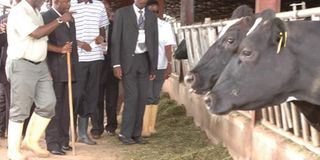Prime
Lessons from dairy farming in Kiruhura

The late James Mulwana (L) leads the visiting president of Burundi Pierre Nkuruziza (2nd L) to inspect his JESA Dairy Farm, at Busunju. Nkuruziza urged Ugandans to be had working. phOTO by Geoffrey Sseruyange
At the weekend, I travelled to Kiruhura District. From the Nyakahita where the new tarmac road; Nyakahita-Kazo-Ibanda-Kamwenge, starts, up to Buremba Sub-county in Kazo County, where I was going, I noticed something which need to be addressed immediately.
Looking at both sides of the road, you see beautiful cattle farms. I used to see that in Kashari area on the Mbarara-Ibanda road. Not that the farms in Kiruhura District have started today, in the past 20 years I have been on that road, the farms were there but had a lot of shrubs while those in Kashari had their shrubs cleared what the people in the area call kukura omwanya.
The Kiruhura farmers have over the years emulated their Kashari counterparts and in a majority of the farms, the unwanted bushes have been cleared. What however need to be addressed is over grazing.
Along the road, I saw those farms looking green, an indicator that they have rains, a few months ago between June and August, the grass had dried which was a sign of drought.
However, much as the farms are green, there is no pasture to talk about, an indicator that the farmers are overgrazing. Some of the farms look like well-trimmed football grounds.
This overgrazing meaning that one has more animals compared to the size of his farm is brought about mainly by the desire to produce more milk.
To some of them the more cows you milk, the more milk, hence, more income from the sell of milk. This would not be a problem if the number of cows corresponded with the size of land. It is recommended that a cow under open grazing need at least two acres. So if you have say 100 acres, don’t have more than 50 cows including young ones after all they are growing anyway. Remember part of the land could be where the family house and garden are, which means you have less than 100 acres for grazing.
When I arrived in Buremba and after having reached deeper in the villages and witnessed the same, I called the sub-county Veterinary Officer. I asked him why he was not teaching the people about the dangers of overgrazing; he told me that when he tells them they don’t listen to him.
Whether this is true or not, the truth is that there is a big problem of overgrazing. It’s also true that the need to earn income from more milk sells could be driving people to overgraze forgetting long term problems they are creating for themselves.
Five years ago when we put a milk cooler in Nkungu Sub-county in Kazo County, they were collecting only 400 liters daily.
Last Saturday they told me that the 3,000 litre cooler was now small. They need a bigger one. Farmers are increasing their herd while their land is not increasing. They need now to start on other methods of feeding their cattle without relying on open grazing.
This, they will grasp it when the political leaders together with the technical people lead the campaign. But first the political leadership from the area should intensify telling the people about the dangers of overgrazing. The leaders should be the examples themselves. I am confident that the farmers will easily heed the call if it is taken up by their leaders.
Am confident because the people in the area are good at learning and transforming. As early as the 1960s, the people in Kiruhura area were leading a nomadic life; with its attendant problems of not growing food, drinking un-boiled milk, etc.
A student then in the 1060s by the names of Yoweri Museveni started teaching his people to settle and stop nomadism. They listened and started settling.
After the war, in 1986, many had settled and fenced their land but it was still bushy with unwanted shrubs. They were still keeping Ankole cows but because many don’t have big pieces of land, they were not benefiting much economically from Ankole cows because many of them have a low milk yield and to benefit from Ankole cow you need to sell them for beef, which requires a sizeable piece of land.
President’s message
President Museveni continued with his message this time telling them to change from Ankole to dairy cows and to remove unwanted shrubs from their land which they did.
He later in the late 1990s introduced milk coolers at sub county level against resistance from the technical people who argued that there was no milk.
Today, almost every parish needs a milk cooler. Now, Kiruhura district could be getting about between Shs4 to 5 billion monthly from milk. Thanks to the efforts of President Museveni.
This message of transforming from nomadism to a settled life where one earns income either from of milk or beef cows is what the minister of Karamoja, Janet Museveni, is preaching to the people of Karamoja.
Like Mr Museveni succeeded in Kiruhura area, she could succeed with time. So the message now to the people of Kiruhura is to stop overgrazing, learn other methods of feeding animals like maize silage, hay and dairy meal.
The local leaders should work on the feeder roads they are horrible. What are they using the money for roads for?
Karamoja’s case
The First Lady and Minister for Karamoja Affairs, Ms Janet Museveni, in 2010 said rearing of dairy goats would be an ideal solution for families in Karamoja region.
At a meeting with officials from Bothar Ireland, an international non-profit organisation based in the Republic of Ireland, Ms Museveni said goats were more secure to rear than cattle, especially for the women. She said goat milk was more nutritious and would benefit the children of Karamoja.




